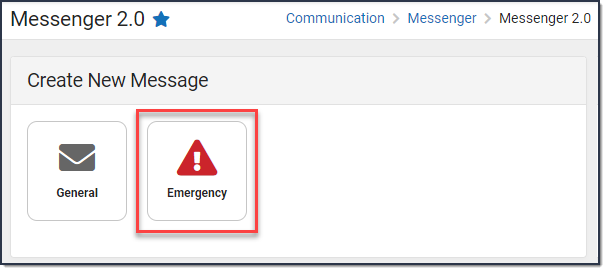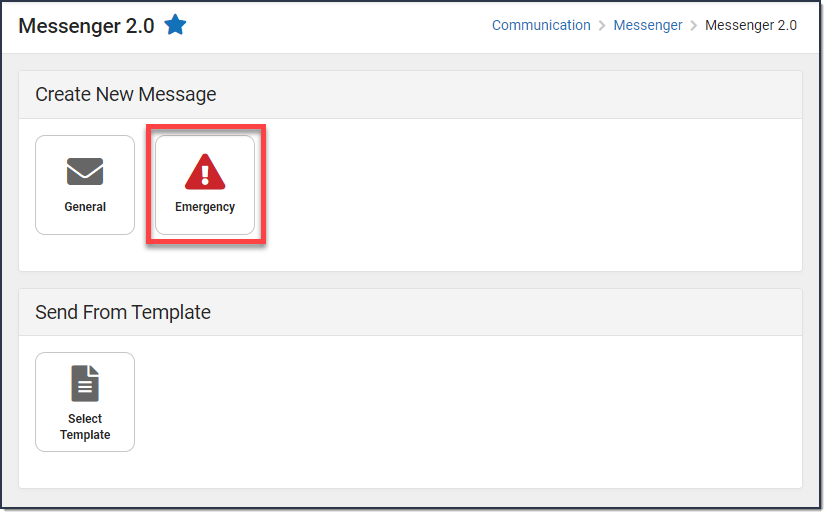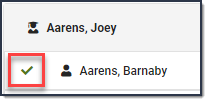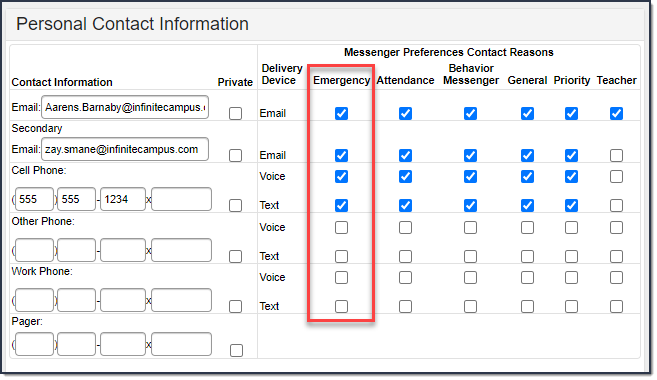You can send an emergency message if you need to quickly create and immediately deliver a message to students, messenger contacts, and/or staff.

| What can I do? | What do I need to know? |
|---|---|
Important Information about Emergency Messages
- Unlike other Campus messages, an emergency message does not have a scheduled delivery window. All messages are delivered immediately or as quickly as possible.
- Emergency messages are NOT limited to the dialing window established by the District Start Time and District End Time fields of the Voice Settings tool (System Administration > Messenger > Messenger Preferences > Voice Settings).
- The Emergency Messenger sends messages to contacts based on the contact phone numbers and email addresses marked to receive emergency messages on the Demographics tool. The Emergency checkbox on the Demographics tab must be marked by the phone number or email address. Phone numbers and email addresses that do not have the Emergency checkbox marked do not receive an emergency message.
- Emergency Messenger also relies on proper designation of a person as a Messenger contact on the Relationships tool.
- Sending out MASS Emails using Freeware like Google as Your Email Server
- Emails exceeding the amount set by the email service provider may fail due to controls set by the provider to prevent SPAM.
- Free email service providers also typically set maximum allowed emails sent per day. After that limit is reached, usually in a 24 hour rolling period, additional emails won't be sent until the time passes.
- For more information about Google's sending limits, see the following articles:
Phone Recipient Confirmation
When voice messages are delivered, Shoutpoint may attempt to reach a recipient at multiple phone numbers. Shoutpoint continues to call recipient phone numbers until the recipient confirms message receipt or until the maximum number of redials is met as allowed by the district (configured in System Administration > Messenger > Messenger Preferences > Voice Settings).
To confirm delivery of a message, a recipient must press 0 at the end of a voice message. This cancels all additional delivery and/or redial attempts for recipients with non-shared numbers or non-extension numbers.
Confirming and cancelling calls to other phone numbers works in the following way:
- Recipients can confirm calls on any phone number, even those shared with any other recipient in Campus.
- If a phone number contains an extension, recipients are not be able to confirm the call.
- Confirming calls to phone numbers for the same recipient does not cancel calls to any phone numbers which contain extensions.
- If a multiple recipients share a phone number but have different Delivery Devices selected for the same Messenger tool (Voice/Text), Voice call confirmation does not cancel the Text message from going out for the other recipient.
To stop additional calls, a recipient should always press 0 to confirm receipt of messages. If a recipient listens to a message but does not confirm its receipt by pressing 0, they may continue to receive call and redial attempts.
Send an Emergency Message
The procedures in this section describe how to send an emergency message via inbox, email, voice or text to students, messenger contacts, and/or staff. For detailed descriptions of each field in the message builder, see the Messenger Field Descriptions article.
To begin, choose one of the following options.
| Option | Description |
|---|---|
| Create a new message |  |
| Use an existing template | Click Select Template > Emergency then select the template you want to use. |
| Step 1. Recipients |
- Select the Delivery Mode: Inbox, Email, Voice, and/or Text.
- Select a School Year.
Tip: The default selection is the current school year. - Select Select Calendars.
Result: The Calendars panel displays. Use the + (plus) and - (minus) buttons to view or hide additional calendars.
Tip: If you chose to create a new emergency message, all calendars to which you have access are automatically selected. - Choose the recipient group(s) from the Send To section.
- Students
- Messenger Contacts
Tip: The Messenger Contact recipient will only receive one emergency message regardless of how many students with whom they have a Messenger relationship. - Staff
- Select a filter option from the Student Selection.
- All Active Students: Includes all students in the selected calendar(s) who have an active enrollment in the current school year or who have a future enrollment but have not started yet.
- All Students: Includes all students in the selected calendar(s) regardless of enrollment status.
- Filter Students: Includes all active students by default with the ability to filter the student list with the following options: Grade Level and Ad Hoc.
- Click the Recipients button to display a side panel to review the recipient list. If necessary, remove recipients and click the Update button on the panel when you are done. (Optional)By default, all recipients are automatically selected to receive the message. Click the person's name to remove them as a message recipient. A checkmark next to the person's name means they will receive the message. No checkmark next to the person's name means they will not receive the message. In the following example, the person will receive the message.

- Select a Preferred Language preference. (Optional)
- Select Next.
Result: Step 2 Content displays.
| Step 2. Content |
- Enter the subject of the message in Message Subject.
- Complete the following Inbox, Email, Voice, and/or Text options.
Option Description Inbox Compose the body of the message in the Message Body.
Attachments are not sent with Inbox messages.
Email - Enter or confirm the correct email is showing in the Reply to Email field.
Tip: This Field is only editable if the Allow Custom Sender’s Email Address checkbox is marked in the Email Settings tab of Messenger Admin. - Enter a Sender Display Name. (Optional)
- Compose the body of the message in the Message Body.
- Click the Select File button to attach a file to the email. (Optional)
Voice Select one of the following options: - Upload - Use this option to attach a pre-recorded .WAV file.
- Text-to-Speech - Use this option to have Campus convert text from the Voice Message Body field on this screen to a voice message. If you are also sending an Email message the Voice Message Body field is not available and the Message Body from the Email card will be converted instead.
Text Compose the body of the message in Text Message Body. - Enter or confirm the correct email is showing in the Reply to Email field.
- Select Next.
Result: Step 3. Send displays.
| Step 3 - Send |
- Confirm you would like to receive a confirmation email that the message was successfully sent by marking the Confirmation Email checkbox. Clear the checkbox if you do not want to receive a message sent successfully email.
- Select Send.
Result: A confirmation displays and the Message Processing Results display. From here you can see how many messages were sent and you have the option to send the message again.




